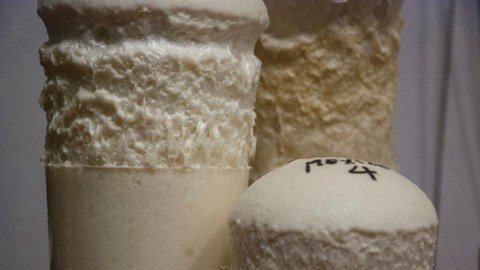 Free Download Science And Technology Of Polyurethane Materials
Free Download Science And Technology Of Polyurethane MaterialsPublished 12/2023
MP4 | Video: h264, 1920x1080 | Audio: AAC, 44.1 KHz
Language: English | Size: 390.42 MB | Duration: 1h 27m
Basic concepts and applications
What you'll learn
Understand the importance of the polyurethanes industry and the different fields where you can have a career.
You will understand which are the main markets and applications of polyurethanes
You will be able to use the properties of isocyanates and polyols to apply them to any industry
You will understand the most relevant chemical reactions of isocyanates and how they affect the microstructure of polyurethanes
How to use the structure-property relationships so as to predict polyurethane properties
Select and understand the additives suitable for each polyurethane industry
You will be able to correlate microstructure, materials employed and technology in flexible and rigid polyurethane foams
You will be able to correlate microstructure, materials employed and technology in elastomers, adhesives and coatings
Requirements
The course is focused to the main audience and the concepts can be acquired without any specific background. If you have a chemical background, you will be able to understand more about polyurethanes. If you have a technical background, this course is perfect for you so as to understand how the main concepts of the polyurethane industry.
Description
This course has the main purpose to serve as an introduction of the polyurethane industry. Due to the intrinsic versatility of polyurethane materials, a special focus is made into the different industries where polyurethane is used as well as its main properties and characteristics. The contents are tackled without the rigor of presenting the complex chemistry behind each polyurethane application, but focusing on the key technical and engineering concepts which are fundamental to achieve it. The course starts with a presentation of the most relevant concepts of polyurethanes, that its, the materials employed to manufacture these polymers. We fcos on the properties of the polyols and the isocyanates as well as key additives employed in the industry. Then, the main chemical reactions taking place are presented focusing on the key concepts and avoiding specific chemical details. The subsequent sections are mostly associated to polyurethane applications. The course covers covers the most relevant applications such as rigid polyurethane foams, flexible polyurethane foams, elastomers, adhesives, thermoplastic polyurethanes as well as other relevant applications. Within each section, you'll be able to learn about the main materials used to attain a specific application, the technologies that are employed to manufacture polyurethane materials and the microstructure that it is required for each of these applications.
Overview
Section 1: Introduction and content overview
Lecture 1 Personal introduction
Lecture 2 Content overview
Section 2: Main polyurethane markets and applications
Lecture 3 Markets and applications
Lecture 4 Market share, main industries
Section 3: Isocyanates and its main chemical reactions
Lecture 5 Isocyanates and polyurethanes
Lecture 6 Isocyanates: main classes
Lecture 7 Isocyanates: main properties
Lecture 8 Isocyanates: chemical reactions
Lecture 9 Chemical reactions : isocyanates + alcohols
Lecture 10 Chemical reactions: reaction rates
Lecture 11 Chemical reactions: urethane reversibility
Lecture 12 Chemical reactions: isocyanates + water
Lecture 13 Chemical reactions: isocyanates + amines
Lecture 14 Chemical reactions: isocyanates dimerization
Lecture 15 Chemical reactions: isocyanates trimerization
Section 4: Main types and properties of polyols
Lecture 16 Polyols: general classification
Lecture 17 Polyols: fundamental properties
Lecture 18 Polyols: hydroxyl value (OH#)
Lecture 19 Polyols: functionality
Lecture 20 Polyols: molecular weight
Section 5: Polyurethane Additives
Lecture 21 Surfactants
Lecture 22 Catalysts
Lecture 23 Blowing agents
Section 6: Structure-property relationships of polyurethanes
Lecture 24 Phase separation
Lecture 25 Isocyanate index effect
Section 7: Flexible and semi-flexible polyurethane foams
Lecture 26 General classification
Lecture 27 Materials and technologies
Lecture 28 Microstructure
Section 8: Rigid polyurethane foams
Lecture 29 General classification
Lecture 30 Materials : isocyanates and polyols
Lecture 31 Materials: formulations
Lecture 32 Technologies: continuous boardstock
Lecture 33 Technologies: spray polyurethane foam (SPF)
Lecture 34 Technologies: injection and moulded
Lecture 35 Microstructure
Section 9: Elastomers
Lecture 36 General classification
Lecture 37 Materials : isocyanates, prepolymers and polyols
Lecture 38 Technologies
Lecture 39 Microstructure
Section 10: Adhesives, coatings and waterborne polyurethanes
Lecture 40 Markets and main concepts
Lecture 41 Applications
Lecture 42 Coatings: polyols employed
Lecture 43 Coatings: main formulations
Lecture 44 Adhesives: types and applications
Lecture 45 Adhesives: wood
If you are a designer, technician, engineer or a scientist which is starting to work in the polyurethane industry, this course will help you to excel in your career. The concepts developed here are key for a broad understanding of the polyurethane industry, particularly from a technical point of view.
Homepage
https://www.udemy.com/course/science-and-technology-of-polyurethane-materials/
Buy Premium From My Links To Get Resumable Support,Max Speed & Support Me
Science And Technology Of Polyurethane Materials Torrent Download , Science And Technology Of Polyurethane MaterialsWatch Free Online , Science And Technology Of Polyurethane Materials Download Online
Comments

